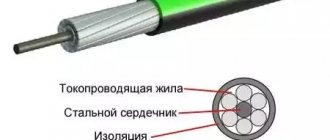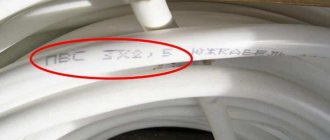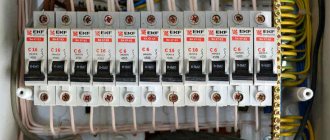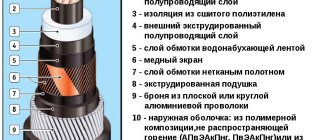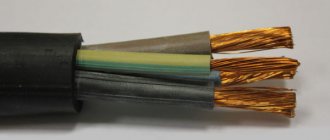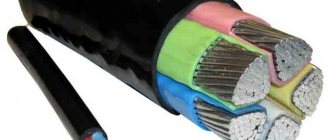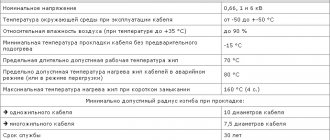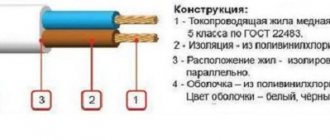It is generally accepted that wires and cables are intended exclusively for connecting electrical energy consumers to power sources. Power cables, which are used as conductors and wires, are designed to operate with direct and alternating current. Their division according to the applied voltage (up to 1000 V and over 1000 V) is familiar to everyone. The PNSV wire has a completely different purpose.
PNSV wire
Operating principle and types of wires
The description of the operating features of conductors of this type is that they are connected to the electrical network through step-down transformers. The wires are laid in the thickness of the concrete mass and, heating up with the passage of current, maintain the required temperature regime. Laying occurs at the reinforcement stage. The cables are attached to the fitting sections.
Laying the wire together with reinforcement
Important! The concrete solution hardens completely in 26-28 days. In the cold season at sub-zero temperatures, the water included in the solution freezes. Hardening of the concrete mixture slows down. When temperatures change (as they rise), the ice melts again. There is no need to talk about the quality of concrete.
PNSV cable and similar products can help get rid of the problem and maintain the temperature of the solution within acceptable limits. The use of this technology makes it possible to reduce the setting and hardening time of concrete by 5-6 times. In this case, the structure of the solution does not change, the concrete does not crack or swell.
Types of heating wires used for heating concrete compositions:
- CDBS;
- VET;
- PNSV.
A cable that has two cores and is used for sectional concrete is KDBS. The advantage of this model is its direct connection to 220 V. There is no need to use a step-down transformer. Laying is carried out according to the required pattern, without cutting, using couplings.
Attention! Dismantling the KDBS after the concrete has hardened is impossible; it itself costs from 60 to 280 rubles per linear meter.
Heating cable KDBS
VET is a Finnish cable with two cores, which similarly allows you to connect yourself to a 220 V network using a special plug and does not require transformation of the supply voltage. Used at temperatures up to -250C. Conductor consumption – 5 l.m. (linear meters) per 1 cubic meter of heated volume, but not less than one kilowatt per 1 m3.
For your information. The price of BET ranges from 76 to 530 rubles per linear meter. It is worth considering that the shorter the product length, the higher the cost.
PNSV is a single-core wire. It can be used several times. When connecting, if the total length of the conductor does not withstand the supply voltage of 220 V, it is necessary to use a step-down transformer.
Installation of sectional heating cable
Today, there are many options for online calculators that are convenient and allow you to instantly get the exact power, quantity, and cross-section of the heating cable. The calculation below illustrates the logic and provides a methodology for carrying out calculations of the most general form.
| Room name | Power W/m2 |
| Non-residential | 110÷120 |
| Residential | 110÷130 |
| Plumbing | 120÷150 |
| Unheated loggia | 180 |
The option of using it as the only element of the heating system will require 160÷200 W/m2.
For example: an electric heated floor is calculated, the required heating area is 10 m2, there is a PNSV of 1.2. Characteristics taken from parameter tables:
- The power of the bedroom floor heater, for the need to provide 120 W/m2, W: 10*120=1200;
- Heater element length 1200 W, specific power 20 watts per linear meter, meters: 1200/20=60;
- On one square meter you need to lay (fulfilling the requirements of the specifications), meters of wire: 60/10=6;
- The ohmic resistance of 60 meters of wire, the resistivity of one meter of steel core is 0.15 Ohms will be, Ohm: 60*0.15=9;
- A heating section connected to a 220V network with a wire with a diameter of 1.2 mm. cannot be less than 110 meters long (specifications). Otherwise, the result will be: the resistance of the shortened element decreases, the current increases, which causes overheating, and the likelihood of destruction increases. The active resistance of the heating section is, Ohm: 110*0.15=16.5. The recommended effective heating current is, A: I=U/R=220/16.5=13.33. Rounded 13 amps.
- The calculated 60 meters of wire are shorter than the normalized length of the section and cannot be directly powered by the network. A voltage step-down transformer is required. You can calculate it like this:
- Secondary winding: voltage, V: U=I*R=13*9=117, power, W: P=U*I=117*13=1521
- Total transformer power, W: 1521*1.25=1901.3
Total: to install a heated floor with an area of 10 m2, you need:
- 60 meters of wire PNSV 1.2;
- Step-down transformer with a power of 2 kilowatts, secondary winding voltage 110÷120 volts.
A welding machine may be a suitable option when selecting a transformer.
The use of a thermostat will increase the comfort of using a heated floor and will allow you to use electrical energy more economically.
Abbreviation and design
For the PNSV wire, the abbreviation decoding describes the following design features:
- P – wire;
- H – for heating;
- C – steel current-carrying conductor (sometimes galvanized or not);
- B – polyvinyl chloride insulation.
Wire for heating concrete
For example, wire pnsv 1*1.2 stands for heating wire with a steel core in a PVC sheath, having one core with a cross-section of 1.2 mm2. The range of sections for use is from 1 to 6 mm2, most often the maximum is 1.4 mm2.
Interesting. A solid core reduces the flexibility of the conductor; with increasing cross-section, this indicator noticeably decreases. If we compare the minimum bending radii (for the wire in question this is 5 outer diameters), then its flexibility is comparable to cables that have class 3 of this parameter. The core insulation ranges from 0.8 to 1 mm.
PNSV design
Popular manufacturers
Domestic and Belarusian manufacturers are leading the Russian cable market:
- JSC "Schuchinsky", Republic of Belarus, produces products in accordance with TU RB 05755944-005-93. The core cross-section is up to 95 mm2, other characteristics and requirements correspond to Russian ones.
- Cable, Pskov region, Velikiye Luki. Product regulations GOST 24334-80, TU 3544-007-41580618-2013. Operating voltage 0.38 and 0.66 kV. The maximum cross-section of cores is up to 240 mm2.
- OJSC "Arzamas Cable Plant" complies with the requirements of GOST 24334-80, TU 3540-004240073-001-2012. The core cross-section ranges from 0.75 to 95 mm2.
- JSC "Marposadkabel", Chuvash Republic, city of Mariinsky Posad. Specializes in the production of modifications of KG cables for shipbuilding, mines, etc. KSTP issues directly under separate contracts.
- “Rybinskkabel”, Russia, Rybinsk city.
- "Kaluga Cable Plant", Kaluga region, Zhiletovo village.
It is impossible to give the exact price of each manufacturer's products, since it is necessary to take into account the volume of the order and the cost of delivery to the buyer's region. All factories have certificates of conformity for their products and are responsible for quality control.
CGTP are products of the latest generation, safe for the user and durable. The products are excellent for use in adverse conditions and can be used at home, in small and large enterprises.
Specifications
Wire PV 3
Heating wires, in particular PNSV, have the following parameters and indicators:
- operating temperature range – -60 to +500С;
- permissible air temperature during installation work – up to minus 150C;
- resistance to electric current – 0.15 Ohm/m;
- working wire consumption – 60 m/m3;
- current when heating concrete (inside the mass) – 15-17 A.
Carefully! The heating current can only be measured when the product is laid deep in concrete. Connecting the wire outdoors is strictly prohibited - the wires will melt and the fittings will be energized.
Technical characteristics of PNSV
Delivery of PNSV
Nobody likes to wait - that’s why we try to deliver cable products as quickly as possible. The speed of delivery of PNSV wire is achieved through cooperation with large transport companies. In addition, we have our own logistics division.
MANUFACTURERS
Application area
PuGV wire
It is used to heat the mass during installation work at industrial facilities in the oil and gas industries, reinforced concrete products and monolithic concrete structures.
In addition, the conductor can be used:
- during the construction and construction of buildings and structures at the initial (foundation) stage;
- for heating water pipelines and sewer pipes;
- for arranging heated floors;
- heating soil in greenhouses.
The product is resistant to water, 30% alkaline solutions (Ca(OH)2, NaOH), salt compounds (up to 20%).
How to connect and lay wire
Regardless of which wire is used, psv with core 1 2 or another, the following requirements must be taken into account:
- calculate the total length of the heating conductor, taking into account the circuit, the volume of the solution to be heated, and the influence of external conditions;
- select the type of connection: single-phase, three-phase (star or delta);
- calculate the sectional connection based on a heating current of 15 A for each section being mounted;
- provide for the use of step-down stations: KTP TO - 80/86, SPB - 80, with body grounding, which provide heating of 20-30 m3 of the working mixture;
- perform uniform laying around the perimeter, maintaining a distance from wire to wire from 15 to 50 mm;
- “hot” contact connections are made in concrete, while the working (hot) sections of the PNSV are connected to “cold” conductors made of copper or aluminum, which, in turn, are connected to the transformer.
Attention! When connecting “hot” and “cold” wires, the connection points are insulated. Connection without adapter wires to the transformer is unacceptable.
Small nuances that will help in your work:
- When calculating the required amount of cable, it is necessary to take into account that the connection is not made in one whole piece. For this, the wires are divided into sections of 16-28 m. To calculate Lmax, you need to know the conductor resistivity (p), which depends on the cross-section. To calculate, you can use Ohm's law (U=I*R) or use an online calculator.
- The voltage supplied to the PNSV usually ranges from 70 to 100 V. This provides the required temperature and heating current.
- It is recommended to lay a layer of foil metal gasket up to 2.5 mm thick between the reinforcement mesh and the heating element. This will increase heating efficiency and eliminate direct contact of the fittings with the wire.
In each individual case, the specific conditions associated with the technology of concrete laying are taken into account. In this case, the heating temperature will depend on the weight of the solution, thermal insulation, the direction and speed of air masses (wind), the size of the formwork and the grade of concrete.
Connection diagram
Connection diagram options
Connections for heating concrete mixtures can be made using two types of circuits: star and triangle.
Turning on conductors
In the first case, one ends of 3 segments of equal length are connected to a common point, and the three remaining ends are connected to the terminals of the PTS. In the second case, the wire is divided into three equilateral conductors, they are connected in parallel. Each set is connected in series and three clamps from the output of KTP TO - 80/86 are connected to common points.
After all joints and connections have been made, the concrete solution is placed in place, and the assembled structure is connected to the network. Power supply to the heating elements is possible only after the solution has been completely laid. It is not recommended to do it any other way.
Power supply block diagram
At home, when working with small volumes of concrete solutions, you can connect the PNSV to a welding machine and heat it by supplying direct current.
Using a welding machine for heating
Warm-up technology
Concrete should be heated using three stages: preliminary, intermediate and final. They are divided by time and temperature as follows:
- preliminary (warm-up) – the temperature is maintained up to 100C for 2 hours;
- intermediate - heating is carried out according to an isotherm (the temperature is constant), while the temperature should not rise above 80 degrees;
- the final stage is when the solution cools; the process speed should not be more than 5 degrees per hour.
When working with concrete, you should not heat it after 50% hardening.
Recommendation. Work on processing concrete surfaces and blocks without waiting for complete hardening can be carried out using any cutting or drilling tool, with the exception of shock loads.
Post-processing of concrete
Such a short period of time for warming up the concrete mass prompts many novice builders to ask whether it is possible to cut and drill concrete before it reaches its original strength.
In fact, you can cut it, but only taking into account one nuance. If you plan to cut with a diamond tool that eliminates the formation of cracks and uneven edges of the holes, then nothing critical will happen. But you will have to wait with impact loads until the concrete meets the required strength grade.
How to replace it
It is permissible to replace the PNSV cable with a PTPZh wire. This is a two-wire broadcast (for radio) conductor, with plastic insulation and galvanized steel conductors. Core diameter – 1.2 mm2. The conductors are arranged in parallel and covered with insulation made of high pressure polyethylene.
PTPZh, appearance
For heating, you can take a 0.6 mm2 core. Also suitable as a replacement:
- PNSP;
- VET;
- KDBS.
The choice of an analogue directly depends on the scope of the proposed work. With the correct calculation of the length and choice of connection diagram, the PNSV will ensure reliable heating of the concrete. Reasonable price and ease of use make this heating conductor accessible for purchase and installation. The ability to change the heating temperature by adjusting the voltage supply will smooth out all small miscalculations when determining the required length.
Concrete mass heating technology
A fundamental mistake is the opinion that in order to achieve a given structural strength of concrete, it is enough to install a heating cable and simply connect it to the network. This process is adjustable and depends on many parameters. Both underheating and overheating of the poured concrete mass are unacceptable.
You will not be able to bring it to a boil, since the vinyl shell melts at 80 0 C. This is a kind of fuse. But if it collapses, the entire heating system will fail, and if the wire comes into contact with the fittings, a short circuit may occur.
Below, as an example, is one of the technological schemes for warming up when sections are turned on with a “Star”.
- The first stage, when the bulk of the water is absorbed and a crystalline structure begins to form in the mass of poured concrete. At this time, it heats up to 55 0 C. Its duration depends on the outside air temperature. For example, at –15 0 C it is 5 hours, at –20 0 C – seven hours. To maintain the process, a voltage at the output windings of the transformer is required to be 95 volts.
- Second phase. It is carried out for isothermal heating and creation of a crystalline structure in the concrete mass. The supply voltage is reduced to 75 volts, and the temperature inside the poured mass of 55 0 C is maintained due to its thermal inertia. The duration and dependence on external temperature is the same as in the first stage. However, during a sudden cold snap, it is recommended to increase the voltage to 85 volts.
- Third stage. Cooling stage. Set of 70-80% structural strength. The heating temperature of the wire is no more than 20 0 C. Duration is 80 hours if outside –15 0 C and 30 at –25 0 C.
